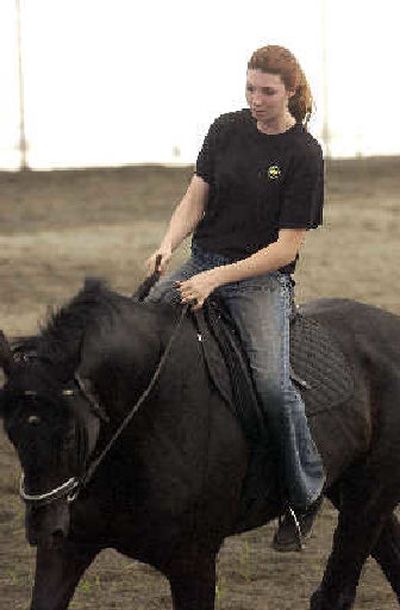Olympic goal

Sarah Frantz has a special understanding with her horses, an understanding that she hopes will take them all the way to the Olympics. Her horses are two Trakehners, Kougar and Kobra, six-year-old stallions of German lineage that her family imported from Denmark in 2001. Frantz is training Kougar for dressage (rhymes with massage), an equestrian sport in which horses perform specific movements in response to bodily cues given by riders, and Kobra for three-phase eventing: dressage, show jumping and cross-country.
On a recent day, 19-year-old Frantz worked with Kougar in the barn/arena on the family’s Rathdrum horse farm. “Dressage is his passion,” she said of the horse as she sat bareback on the animal. “He’ll go over a jump because I say to, but much more quickly he’ll dressage around it.”
She speaks about her horses as if she knows what they’re thinking and talks about what they tell her because she’s a “horse whisperer” of sorts, practicing “natural horsemanship,” a training method that dovetails with dressage, she says. Natural horsemanship is a gentler kind of training that works with a horse’s behavior, instincts and personality.
“The (horse’s) mind is just as important as the body,” Frantz said. “Natural horsemanship builds a stronger relationship with the horse … helps to strengthen communication.”
“He (Kougar) gets stronger and stronger mentally. He tries to figure things out, instead of just cause and effect … there’s a lot of horse psychology. How the horse responds to things in the wild, to each other. It’s amazing I’m still alive with what I didn’t know.”
Frantz grew up around horses. Her mother, Cindy Frantz, raised and bred Trakehner mares.
Then her mom decided to get a stallion. “Mom came to me and said, I think it would be fun to own an approved stallion,” approved designating exceptional breeding. They went to Denmark, found the two horses, and unable to choose between the two, purchased both.
Sarah Frantz had decided that to go to the Olympics, she’d need the right horse to take her there. That proved to be Kougar and Kobra. “The opportunity kind of presented itself.”
Natural horsemanship, she says, is helpful in dressage, in which the horse must respond to very subtle clues, such as the rider shifting his weight, moving his shoulders or even holding his head in a certain manner.
There are three basic gaits to dressage, explains Cindy Frantz: walking, trotting and cantering. In dressage, the horse lengthens or shortens its stride, raises or lowers its legs, reverses, turns on its haunches, or moves sideways, on time and on cue. They also trot in place, called piaffe, or slow their trot, called passage.
There are 25 different levels of dressage, beginning with training and ending at Grand Prix, that a horse must achieve before it is ready for the Olympics. “At the Olympic level, there are very high-schooled movements,” Cindy Frantz said.
“The higher you go, the more refined you have to be,” Sarah Frantz said. “You have your leg back a quarter of an inch and it means something totally different.”
“By the time they get to the highest level, there are hundreds of combinations of cues they have to learn,” Cindy Frantz adds.
The Frantz stallions are about halfway through the levels and Sarah Frantz hopes they’ll be ready in four years for the Olympics.
“(Kougar) could be at Grand Prix in six months if he was training with someone who had been to Grand Prix,” she said. But she’s learning as he’s learning. “It’s green on green,” she said.
In North Idaho, it’s difficult to find trainers or riders who’ve been to highest level, she added.
And it takes more than just achieving the Grand Prix level. “It takes several years of consistently being the best to be invited [to compete in the Olympics],” Sarah Frantz said. “People have to know your name, especially the German judges,” who are influential in dressage competition.
But while going to the Olympics with her horses is the goal she’s working toward, it’s not the ultimate one. “The ultimate goal is to have total communication and understanding,” she said.